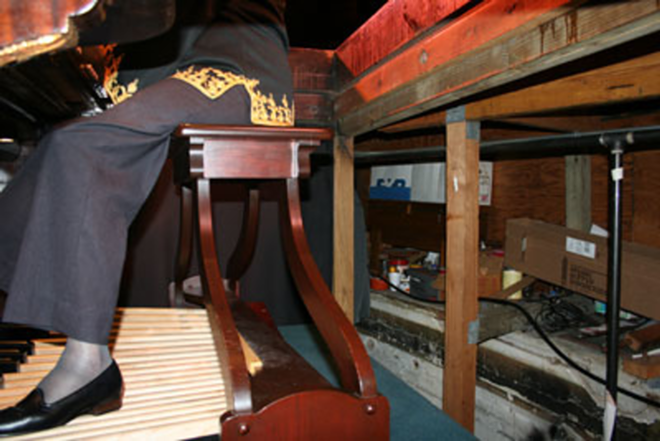
Where: Under the stage at the Tampa Theatre
Public access: None — unless you've got business with the Mighty Wurlitzer. The below-stage space (formerly the pit for the Tampa Theatre Symphony Orchestra) is home to the theater's most prized possession, its pipe organ — which, of course, rises up through the stage floor with an organist aboard whenever an overture or other accompaniment is called for.
Element of danger: None, unless you plan to stand next to the scissor lift when the organ is making its descent.
Why we went: The nagging question, "Where's the organ go?"
What we discovered: Well, it's not exactly roomy down there. Getting seated at the organ requires some maneuvering — the lift apparatus is surrounded by a wooden scaffold masked by black curtains, so the organists have to be careful when they make their way up steps and onto the bench. But for vets like Rosa Rio and Bob Baker, it's routine. "Ninety-five percent of the fun of playing this organ is riding it up and down," says Baker. The player controls the movement of the lift with a button on the organ keyboard, taking it only part of the way up — that's called "picture level" — when the organ is meant to be heard but not seen (for instance, when it's accompanying a silent film).
Bits of recent and ancient history clutter the basement where the organ is located: an old set of bass pedals ("it's like kick-starting a Harley when they don't work," says Baker); box after box of light bulbs and fluorescents; the arc of an old keyboard; a sheet-music collection of "1,000 Standard Tunes"; and on a bulletin board in the hall, a Tampa Morning Tribune clip from 1926 touting the theatre's young organist and its new Wurlitzer, "said to be one of the best in the entire country." Exiled to a church in the late 1950s, restored and reinstalled in the theater in 1986, the Wurlitzer still lives up to its mighty reputation.

